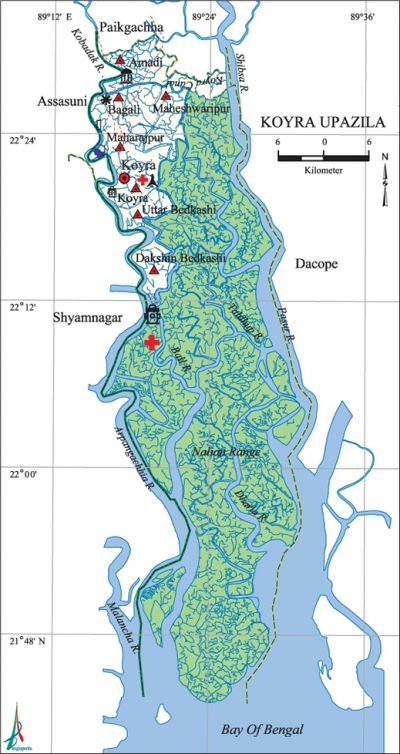Koyra Upazila
Koyra Upazila (khulna district) area 1775.40 sq km, located in between 22°12' and 22°31' north latitudes and in between 89°15' and 89°26' east longitudes. It is bounded by paikgachha upazila on the north, the bay of bengal and sundarbans on the south, dacope upazila on the east, assasuni and shyamnagar upazila on the west.
Population Total 193931; male 95393, female 98538; Muslim 152980, Hindu 40197, Christian 476 and others 278.
Water bodies Main rivers: dharla, pasur, arpangachhia, Taldhup, Malancha, kobadak, ball; Koyra canal is notable.
Administration Koyra Thana was formed in 1980 and it was turned into an upazila in 1983.
| Upazila | ||||||||
| Municipality | Union | Mouza | Village | Population | Density (per sq km) | Literacy rate (%) | ||
| Urban | Rural | Urban | Rural | |||||
| - | 7 | 72 | 133 | 11594 | 182337 | 109 | 58.1 | 49.9 |
| Upazila Town | ||||||||
|
Area (sq km) |
Mouza |
Population |
Density |
Literacy rate | ||||
| 10.06 | 1 | 11594 | 1152 | 58.1 | ||||
| Union | ||||
| Name of union and GO code | Area (acre) | Population | Literacy rate (%) | |
| Male | Female | |||
| Amadi 10 | 10347 | 16352 | 16832 | 56.6 |
| Uttar Bedkashi 94 | 102548 | 7512 | 7713 | 55.5 |
| Koyra 55 | 152484 | 16327 | 16903 | 52.4 |
| Dakshin Bedkashi 22 | 110452 | 8370 | 8385 | 36.6 |
| Bagali 11 | 12050 | 16840 | 17637 | 50.3 |
| Maharajpur 72 | 193298 | 14994 | 16074 | 41.0 |
| Maheshwaripur 78 | 231793 | 14998 | 14994 | 56.0 |
Source Bangladesh Population Census 2011, Bangladesh Bureau of Statistics.
Archaeological heritage and relics Buro Mosque (Amadi union, 15th century), Parimala Statue (Chamunda), Mali Bari Mosque, Dhali Bari Mosque, Madinabad Fakirbari Mosque, Mosque Al Hera, Barabari Puja Mandir (Uttar Bedkashi), Banskhali Bahadur Bari Mandir (Bagali), Haripur Kali Mandir (Uttar Bedkashi), Mathbari Durga Mandir (Maharajpur), Radha Govinda Mandir (Bagali), Madinabad Mandir.

War of Liberation Koyra Upazila was under Sector 9 during the war of liberation. The headquarters of the sub-sector of Sector 9 was established in Koyra. Most of the operations of the freedom fighters (Muktibahini and Mujibbahini) were launched from the headquarters. The freedom fighters established two camps one at village Jhileghata and the other at village Bamia of the upazila. The camps were named after Martyr Narayan and Shuarawardhi. A secret medical centre run by Dr Rafiqul Islam at Jaigirmahal played an important role in medical treatment of wounded freedom fighters. A mass grave has been discovered at Koyra Launch Ghat No. 4 at Morighata).
For details: See কয়রা উপজেলা, বাংলাদেশ মুক্তিযুদ্ধ জ্ঞানকোষ (Encyclopedia of Bangladesh War of Liberation Bangla Version), বাংলাদেশ এশিয়াটিক সোসাইটি, ঢাকা ২০২০, খণ্ড ২।
Religious institutions Buro Mosque (Amadi), Mali Bari Mosque, Dhali Bari Mosque, Madinabad Fakirbari Mosque, Mosque Al Hera, Barabari Puja Mandir (Uttar Bedkashi), Banskhali Bahadur Bari Mandir, Haripur Kali Mandir (Uttar Bedkashi), Mathbari Durga Mandir (Maharajpur), Radha Govinda Mandir (Bagali), Madinabad Mandir.
Literacy rate and educational institutions Average literacy 50.4%; male 55.8%, female 45.2%. Educational institutions: college 3, secondary school 35, primary school 112, community school 11, satellite school 9, madrasa 27. Noted educational institutions: Kapatakha College (1984), Jobeda Khanam College (1996), Kamaruddin High School, Koyra Madinabad High School, Sundarban Secondary School, Uttar Bedkashi Secondary School, Dakshin Bedkashi Secondary School, Amadi High School.
Newspapers and periodicals Kapatakha (2002).
Cultural organisations Library 1, cyclone centre 12.
Tourists spots The extended Sundarbans on the eastern and southern parts of Koyra upazila and the tourist resort at the entrance of the Sundarbans (Maheshwaripur) are the notable tourist spots of the upazila.
Main sources of income Agriculture 66.64%, non-agricultural labourer 7.12%, industry 0.51%, commerce 12.66%, transport and communication 1.85%, service 3.54%, construction 1.31%, religious service 0.31%, rent and remittance 0.09% and others 5.97%.
Ownership of agricultural land Landowner 62.76%, landless 37.24%; agricultural landowner: urban 63.51% and rural 50.74%.
Main crops Paddy, potato, vegetables.
Extinct or nearly extinct crops Sesame, linseed, sugarcane, kaun.
Main fruits Mango, blackberry, banana, jackfruit, coconut, papaya, betel nut, watermelon.
Fisheries, dairies and poultries Shrimp gher 3138, hatchery 5, shrimp depot 273, nursery 6.
Communication facilities Pucca road 46 km, semi-pucca road 172 km, mud road 394 km; waterway 5 km.
Extinct or nearly extinct traditional transport Palanquin, horse carriage, bullock cart.
Noted manufactories Rice mill, oil mill, flour mill, saw mill, ice factory.
Hats, bazars and fairs Hats and bazars are 28. Hugla Hat, Amadi Hat, Ghorilal Hat, Sutar Hat, Ghugrakati Hat, Khoralkati Hat; Jorsingh Bazar; Dakshin Betkashi Banbibir Mela, Padmapukur Rath Mela, Hariharpur Rath Mela are notable.
Main exports Fish fry, timber, golpata, honey, handicraft.
Access to electricity All the unions of the upazila are under rural electrification net-work. However 25.2% of the dwelling households have access to electricity.
Sources of drinking water Tube-well 44.3%, tap 0.3% and others 55.4%. The presence of arsenic in an intolerable level has been detected in 199 shallow tube-well water of the upazila.
Sanitation 58.0% of dwelling households of the upazila use sanitary latrines and 33.1% of dwelling households use non-sanitary latrines; 8.9% of households do not have latrine facilities.
Health centres Hospital 1, upazila health complex 1, charitable hospital 1, family planning centre 2, clinic 8.
NGO activities Operationally important NGOs are brac, proshika, Prodipan. [Md Ashraful Islam Goldar]
References Bangladesh Population Census 2001 and 2011, Bangladesh Bureau of Statistics; Field report of Koyra Upazila 2007.
